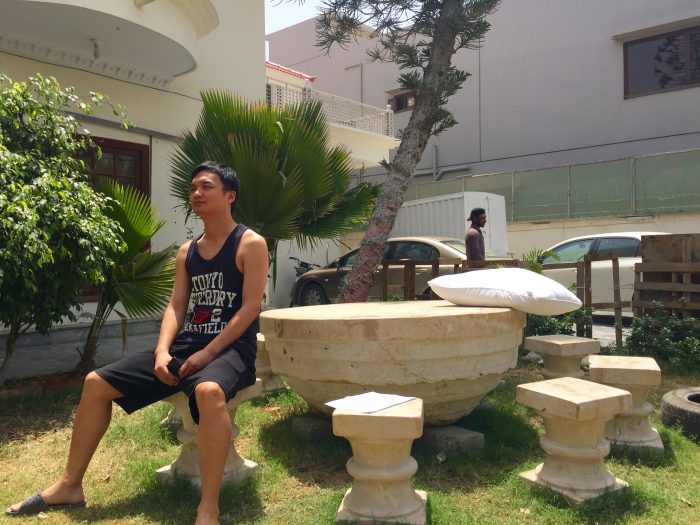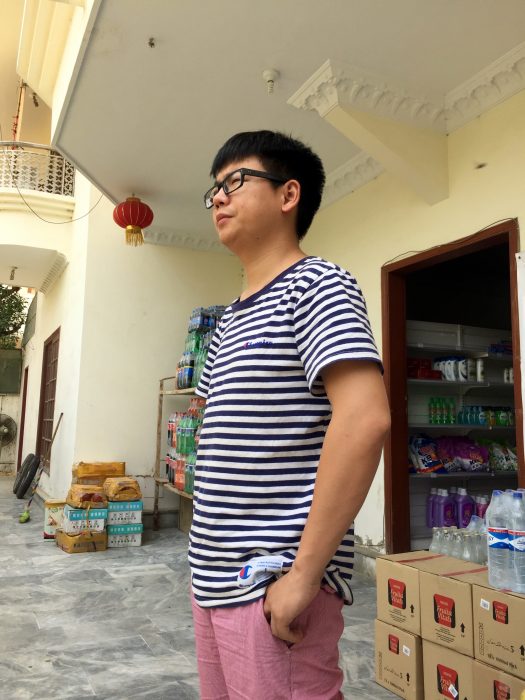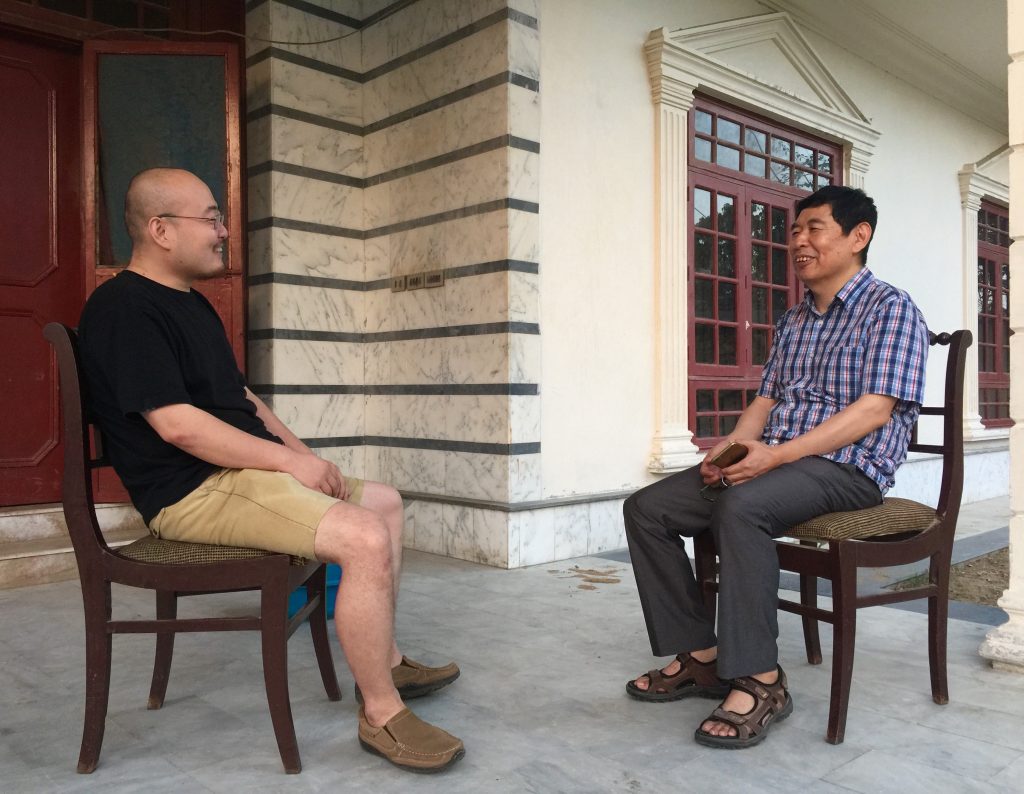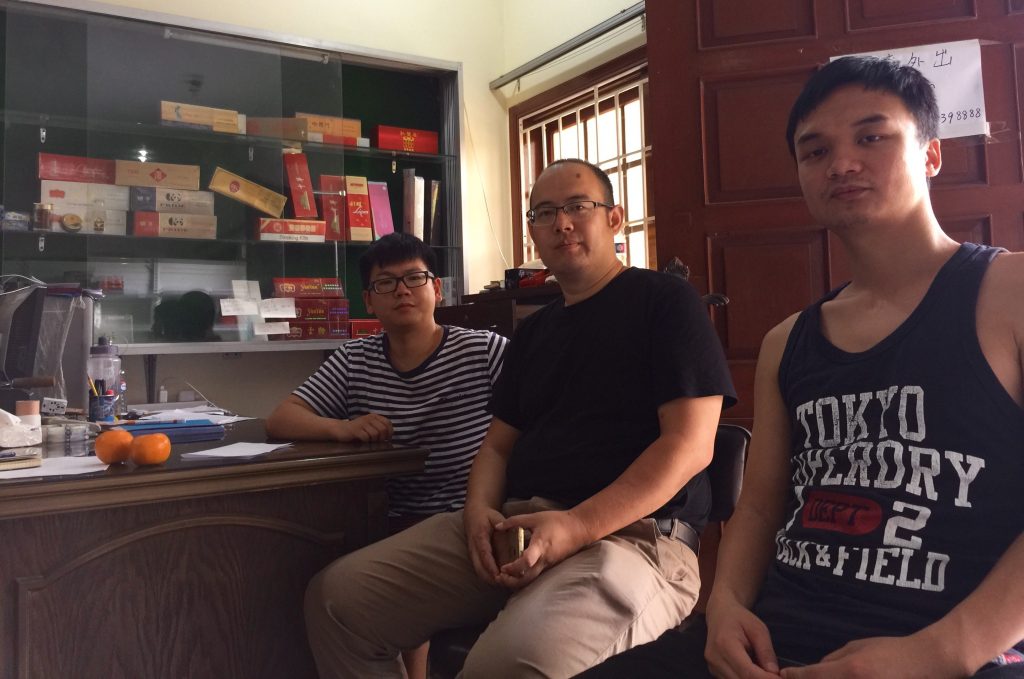Chinatown
By Ali Bhutto | Cover Story | Published 7 years ago

Dyrus Luo, from China’s Hunan province, lives in Lahore and is visiting Karachi. (Photos: Ali Bhutto)
From the outside, the home of Wang Zheng Ru is like any other bungalow in DHA, Karachi. Overlooking a major thoroughfare, it stands amongst a long row of houses and mansions built in the ’80s and ’90s. A contingent of Rangers suddenly emerges from its gate and mounts two Daihatsu pick-ups. Seated in my car, I avert my gaze and pretend to stare into my phone. After the two vehicles are a safe distance away, I ask the policeman at the gate if I should come back another day. He reassures me that that was only the census team.
Moments later, I am received by Zhai Yizhong, or ‘Joey’ as he is known to his friends. Having read my brief introductory note explaining the reasons for my visit, Joey has approved my entry into Zheng Ru’s house, which serves as a guesthouse for Chinese citizens posted in Pakistan. The environment inside the house abides by a set of patterns and laws that set it apart from most urban living spaces in Pakistan. If one did not know foreigners occupied the home, one would easily assume that it was a house used by an organisation – but even then, its alien characteristic would be hard to ignore.

Tony Jiang in his cousin’s house in Karachi.
Thirty-three-year-old Joey hails from Hangzhou, the capital of Zhejiang province, and speaks fluent English. As we wait for Zheng Ru to return from work, Joey throws a few nuggets of Chinese wisdom my way: “The first step towards strengthening an economy is building roads.” He is not, however, affiliated with the China-Pakistan Economic Corridor (CPEC), having been posted to Pakistan in 2015 on behalf of a textile chemical provider, a partner of of a local company. Recalling his first impression of Lahore, he reflects, “it reminded me of the China that my parents describe as having existed 30 years ago.” Joey predicts that in about three decades, Karachi will be Pakistan’s Shanghai.
Zheng Ru, the patriarch and owner of the house, has lived in Pakistan since 1987 and is a relic of the pre-CPEC generation of Chinese professionals who paved the way for the younger lot that now occupies their homes. He is a man of a few words, which he doesn’t mince. “In 1987, Karachi was better than Bangkok, Beijing and Dubai, as far as living standards, transportation and communication were concerned,” recalls Ru. “But in the last 30 years it hasn’t made much progress, those three metropolises having overtaken it.” He recalls that while Karachi had cars in 1987, Beijing had mostly bicycles. “Perhaps it was terrorism that stunted infrastructure development in Pakistan, or perhaps it was political corruption. This country needs a very powerful leader — democracy has always been weak here. That is why I think army rule is better for Pakistan.”

Luo and Jiang in the front yard of their Karachi home.
Seated in the front yard, our conversation is punctuated by the passage of Chinese residents, including stylishly dressed women in their 30s, a five-year-old who chats to me in Mandarin and Mrs Wang Zheng Ru, who runs the house.
According to Mr Ru, there are many similarities between Chinese and South Asian culture: “In China too, people live with their parents, in large families.” A qualified civil engineer, Ru was the China Beijing Corporation’s representative in Pakistan until last year, when he retired. He is currently working for the Shaanxi Foreign Economic Trade and Industrial Group (SFETIC), a stated-owned enterprise under the provincial government of Shaanxi, as an executive manager for the Fazaia Housing Scheme project, in Karachi. Fazaia, a project of the Pakistan Air Force, signed a project development and construction contract with the SFETIC, in July 2016.

Joey (left) and Zheng Ru, in the latter’s home in Karachi. (Photo: Ali Bhutto).
“Living in Pakistan, you realise that it’s not as bad as the media portrays it to be. The people are very friendly,” says Ru, who has also lived in Rahim Yar Khan and Islamabad. He tells me that some of Joey’s friends visited Karachi in the late 1980s and stayed in this very guesthouse, and that it was based on their positive reviews that Joey decided to come here. Nevertheless, Ru always carries one security guard with him when he steps out. Joey too, has a bodyguard — a former army man who is also his driver, and whom Joey refers to as a “friend.”
Yet the sinister realities of life in Pakistan inevitably creep in. Not too far away, in another guesthouse, dwell younger Chinese nationals who have a different tale to tell. In the lobby of the residence is a home-based grocery store that sells household items from Chinese cigarettes and gum, to Chinese detergents. Dyrus Luo is visiting Karachi from Lahore, where he works at the branch office of Sany Heavy Industry, China’s largest manufacturer of construction equipment. Luo, who hails from South China’s mountainous province of Hunan, associates Lahore with “culture” and “humility” and Karachi with “energy” and “openness.” Contrary to popular opinion that people from China stick to each other, Luo is sociable and fluent in English. But he is unable to leave the house much.
“We have been advised by the Pakistani government not to venture out of our homes as it is too dangerous,” he explains. “As a result, our gate is always closed and we don’t have much communication with locals. If I was married, I wouldn’t bring my family here due to the security issues.” His housemate Tony Jiang, however, does get around. “I like the beach and the cheap sea food,” says Jiang, who may look like a college student, but has in fact worked for RNS Logistics in Lahore for three years and is currently posted in Karachi.
Luo, having been in Pakistan barely three months, has noticed that, “the government seems to care more about the military and protecting the country, rather than the problems of the people living in it.” Sounding like a local, he says that outside the bubble of Clifton and Defence, there is extreme poverty, about which the government is not doing enough. Luo is used to unfamiliar environments, having been posted to different parts of the globe over the past six years.

Left to right: Tony Jiang, Xu Jason and Dyrus Luo in the lobby of a Chinese-owned guest house in Karachi. (Photo: Ali Bhutto)
Similar security concerns are shared by Ma Long Zhou Tin, or as he is known by his Muslim name, ‘Omar,’ an engineering supervisor at a CPEC-affiliated construction company operating in Port Qasim (which he requests not to be named). The guesthouse in which he lives, in Block 5 Clifton, Karachi, is a series of independent units that can be occupied by up to 20 Chinese nationals at any given time. Although Omar likes dining at Do Darya, he and others in the compound are not allowed to go out everyday. When they do venture out, it is always under the cover of security.
Omar uses WeChat, an instant messaging and calling app developed by Tencent, China’s leading Internet service provider. “It’s better than Whatsapp,” he says. “Many Pakistanis are now using WeChat,” the total international users of which currently amount to 846 million. Omar and his housemates also have access to channels broadcast by China’s state television.
“Due to congestion and overpopulation, apartments in China aren’t very spacious,” explains Omar, who is from Lanzhou, the capital of the northwestern Chinese province of Gansu. “In Pakistan, on the other hand, the homes we live in are much larger,” he says. Prior to being posted to Pakistan in 2015, Omar was in Yangquan, Shanxi (not the same province as Shaanxi). When Omar was first offered a posting in Pakistan, he says he was a little bit scared because all he knew about the country was what he had seen of it on TV: bombings and terror. But the move provided a good career opportunity. And besides, he says, “most Chinese people I know like Pakistan, otherwise they would not be here. If we cannot bear the life here, there is nothing stopping us from leaving.”
According to Peng Simin, Editor-in-Chief of Huashang Weekly, a Chinese and English newspaper based out of Islamabad, there are currently at least 50,000 Chinese nationals living in Pakistan. And given the myriad ventures they are involved in, chances are this number will rise over the next few years.
Who’s Afraid of the Dragon?
While the Pakistani media remains highly sceptical of CPEC, locals at the grassroot level are enthusiastic about the surge in Chinese residents in Pakistan, whom they view as harbingers of development and stability in the face of local alternatives that have repeatedly failed. “In the last two years, I have noticed a marked increase in Chinese people in Karachi,” says Muhammad Ashraf, who has sold bed linen and curtains out of his shop in Khadda Market for 17 years. “It can only bode well for our country. The CPEC will bring about prosperity. And whether we like it or not, the Chinese, on the whole, seem to be much more humane than our own people.” Ashraf explains that the 25 Chinese clients that frequent his shop are all very kind and respectful. According to Ashraf, while many livelihoods currently suffer at the hands of loadshedding, the Chinese energy projects aim to end the power shortage and this will only result in increased profitability across the board. Some of Ashraf’s acquaintances have bought property in Gwadar for Rs. 3 to 4 million, which is cheaper than property in DHA, Karachi. Taxi driver Huzoor Bux too has a soft spot for his roster of regular Chinese clientele who are concentrated in a residential pocket of DHA Phase IV.
Professionals, however, are less optimistic. Kashif Iqbal, a local coordinator for New Technologies, a Chinese company that has been operational in Pakistan for eight years and currently provides security equipment to CPEC projects, tells Newsline that the CPEC is, inevitably, designed to cater to the needs and interests of China. “There is need of a policy or rule that enables local vendors to benefit from CPEC projects as well,” suggests Iqbal. “Currently, the main benefactors are Chinese companies, who are the preferred choice of the Pakistan government as they provide lower cost services in CPEC projects compared to local organisations.” He is quick to add, however, that there is no denying that these Chinese companies are, technologically, far more advanced than local competitors.
Abdur Rehman Shah, a research associate at Islamabad’s Centre for Research and Security Studies, who is currently doing a PhD in International Relations at Jilin University, in China, also raises some concerns. While talking to Newsline, he warned that if the Pakistan government did not properly manage the increased influx of Chinese nationals and investors in Pakistan, it could lead to a rise in cases where Chinese nationals/workers/businessmen start neglecting or violating laws. “Above all, there can be economic costs,” explains Shah. “Local industries and, to some extent, labourers will have to bear the brunt of the increasing footprint of Chinese nationals in Pakistan.”
According to Shah, current indicators regarding Pakistan’s rising debt obligations towards China are grim. “The government is more focused upon launching projects rather than justifying them on the basis of economic feasibility,” he laments. “The very lack of transparency in CPEC deals compounds the problem. Unlike the US, World Bank and IMF, the Chinese fundings are not bound by the conditions of economic reforms.” Shah points out that China’s official narratives on the One Belt, One Road (OBOR) iniatives, as well as the CPEC, “are steeped in overly promising rhetoric.” Environmental considerations have also taken a backseat in CPEC projects. This, Shah reflects, is emblematic of China’s development model.
Commenting on the Pakistani media’s overly hawkish stance on CPEC, Dr Asad Zaman, Vice Chancellor of the Pakistan Institute of Development Economics and a PhD in Economics from Stanford University, told Newsline that “the media can play a positive role by focusing on how we can best exploit the tremendous opportunities created by the CPEC, which may pass us by if we keep bickering, and fail to recognise them. Repeating baseless apprehensions creates an impression of a scare-mongering propaganda campaign launched by Indians, sworn enemies of the CPEC project.” According to Zaman, fears regarding the debt burden are grossly exaggerated. He argues that since the debt is being used to finance infrastructure projects, it is of a constructive nature and will bring about immediate benefits to the domestic economy, as well as having a short payback period.
Zaman states that Joint Working Groups and Joint Vehicles are being encouraged between Chinese and Pakistani enterprises to safeguard and develop local industries. He points out that while a total of 2,065 Chinese workers are employed in CPEC projects in Pakistan, they are far outnumbered by the 8,523 Pakistani workers employed in the same projects. He adds that more than 50 per cent of the Chinese nationals that have entered Pakistan are categorised as temporary labour migrants who will return to China upon completion of the projects.
Zaman rebukes comparisons drawn by the local media, between the CPEC and the British East India Company. “Instead of looking back several centuries at the worst cases of imperialism, we should look at how foreign direct investment (FDI) has been strongly correlated with growth performance in recent history,” he argues. “Consider how the development of USA was accelerated by European investors, while the US investment in Europe under the Marshall Plan led to rapid reconstruction of Europe.” He cites that the performance of the Chinese economy over the last two decades was helped by a large influx of FDI into China. “The declared exploitative intentions of the imperialists stand in dramatic contrast to the visionary OBOR initiative of China which is based on replacing conflicts with stability, recession with cooperation and barriers with connectivity.”
The writer is a staffer at Newsline Magazine. His website is at: www.alibhutto.com


